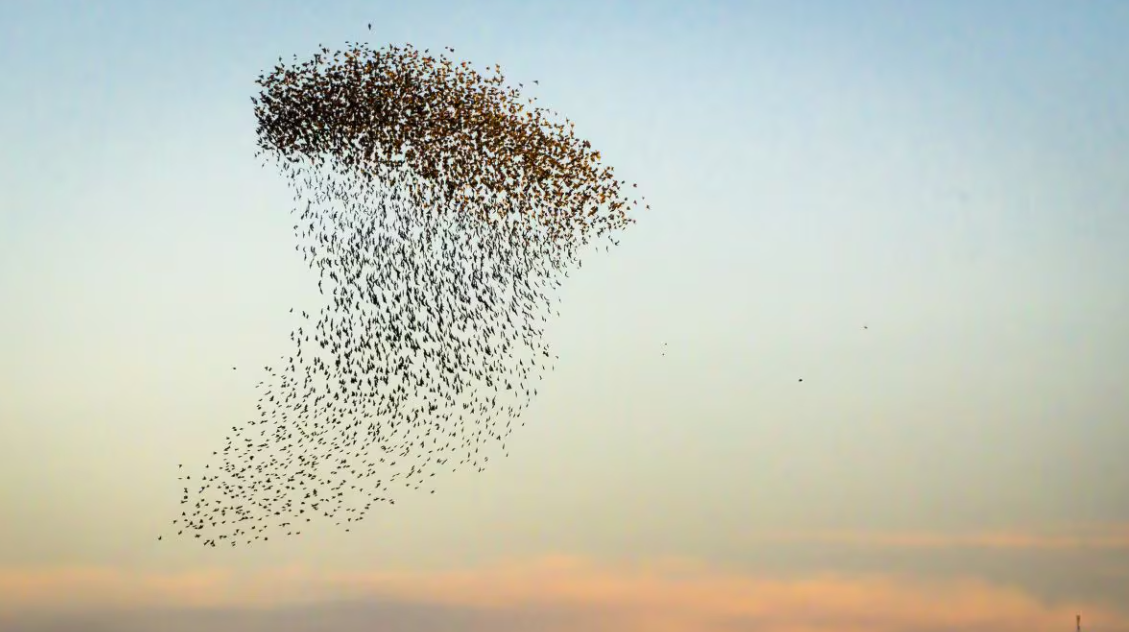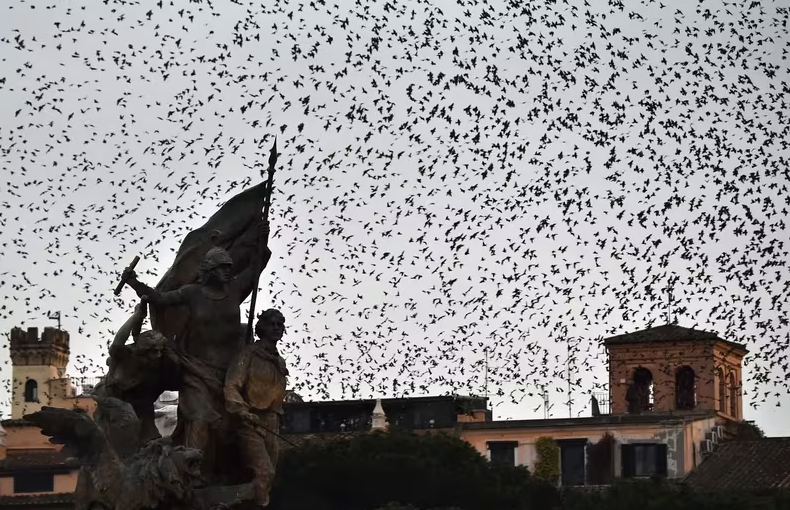The synchronized, single-direction murmurations of starlings have taken over the Italian skies after fleeing the cold from their native territory.

All residents and tourists traveling to Rome are struck by a natural and seasonal phenomenon that causes the Roman sky to darken before nightfall. This process is also caused by a wide range of migratory birds, known as starlings, that arrive in the Italian capital after fleeing the cold from northern Europe.
These small-headed, black-feathered, long-tailed birds ritually spread their wings each year in cities with better climatic conditions than their own native region. For this reason, the Roman city is the preferred destination for these migratory birds, as more than 500,000 birds typically fly over each year.

However, the gathering of more than 40,000 starlings, all following a single direction thanks to perfect synchronization, is known as ‘murmurations’, according to the British, and they have the capacity to turn the sky black with their presence, depriving all those who observe this phenomenon of natural light.
Starling flocks, a ‘complex system’, scientists say

Every year, with the arrival of cold weather, millions of these flocks of small, black-plumaged birds migrate from northern Europe to Italy, heading for warmer regions. The hordes of starlings perform spectacular, perfectly coordinated aerial ballets above the imposing Roman monuments, sometimes darkening the sky before the astonished gaze of passersby.
As the sun sets in central Rome, five people dressed in white jumpsuits stand under the trees with loudspeakers emitting a mix of high-pitched sounds that generate the stampede of flocks of starlings. “I’ve never seen anything like this in my life… It’s incredible!” confesses Eva Osuna, a Spanish tourist, as she uses her mobile phone to capture the birds against a sky that is tinged with the resplendent colors of the legendary Roman sunset.
This species of passerine bird, which measures up to 20 cm, “spends the day in rural areas, where it finds food, and returns to the city at night to sleep,” explains Francesca Manzia, an ornithologist and local representative of the Italian League for the Protection of Birds (LIPU).
Read more: Sore throat: a symptom of omicron or caused by air conditioning?
These migratory birds fly in flocks as a strategy to survive and avoid predators. This year, experts estimate that between 500,000 and one million birds have arrived, despite the setbacks they suffer and cause.
In addition to noise pollution, “starlings are a problem primarily because of their droppings, which cover avenues with mountains of feces, causing accidents and slipping of pedestrians, in addition to the strong stench,” Manzia emphasizes. “But they don’t transmit diseases,” the expert emphasizes.
To limit the disturbance, the city council is trying to scare the birds away using a natural method, using loudspeakers and flashlights used by “hunters” hidden between cars. “We take advantage of their fear response, using the alarm call. It’s as if they’re communicating to each other that the area is dangerous and it’s best to move away,” Marianna Di Santo, director of the private company Fauna Urbis, which was commissioned by the Rome city council to carry out the program, told AFP.
Dormitories
“A few years ago, they weren’t so common in urban areas,” explains Manzia. “But in the city, temperatures are higher, and the lights help them orient themselves and protect themselves from predators.” Some trees in the capital are used as dormitories by starlings, which is why it’s common to find sidewalks, cars, and motorcycles covered in thick layers of droppings, as is the case along the Tiber River.
Some Romans don’t dare venture along the riverbanks without opening their umbrellas. Because of the residents’ exasperation, authorities have tried to keep them away with hawks and lasers, but the sound method is “the simplest and most effective,” says Valentina de Tommaso, an employee of Fauna Urbis.
Read more: Syria: More than 150 dead in fighting after prison attack
The company operates “two or three times a week,” sometimes near Termini station, an area the birds love because it’s bright and protected from the wind. “We play recordings of about 10 minutes, with pauses so they don’t get used to the noise,” a “disruptive” but harmless method intended to break up the swarms and limit the damage they cause, she adds, dressed head to toe in a jumpsuit adorned with reflective strips. Amidst passersby, tourists, and workers, the flocks of black birds flee amid high-pitched, piercing screams, giving the scene the air of something out of a horror movie.
“Walking under clouds of starlings isn’t ideal,” laments Francesco Fusco, a 55-year-old engineer, while 16-year-old student Alessio Reiti is enchanted by this magnificent natural phenomenon. “They’re magnificent. I really like the shapes they create. You can’t put nature in diapers,” he comments, amused.


